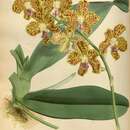zh-TW
在導航的名稱


Phalaenopsis hygrochila, also known as 湿唇兰 (shi chun lan) in Chinese,[2] is a species of epiphytic orchid native to Assam, Borneo, China South-Central, China Southeast, East Himalaya, Laos, Malaya, Myanmar, Bangladesh, Nepal, Sumatera, Thailand, Vietnam and West Himalaya.[1]
This species has a complex taxonomic history and has been previously assigned to several genera.[1]
The 5–10 cm, sometimes up to 20 cm long stems are 8–15 mm wide and enclosed within persistent leaf sheaths. They bear oblong to obovate-oblong, unequally bilobed, coriaceous leaves, between 17 and 29 cm in length and 3.5-5.5 cm in width. Yellow flowers of 4–5 cm in diameter with purple spotting and a white lip with lavender colouration on the midlobe are produced on 5-8 flowered, axillary and often pendent inflorescences. One plant may produce up to 6 inflorescences at a time. Flowering occurs throughout June and July. The diploid chromosome count is 2n = 38.[2] Each pollinium is completely divided into two unequal halves.[3] The seeds are 238.7 µm long and 81.2 µm wide.[4]
Botanical illustration of Phalaenopsis hygrochila as Vanda parishii
The plants are found in open forests in elevations of 700–1300 m.[2]
This species is protected unter the CITES appendix II regulations of international trade.[5]
It has been utilized as an ornamental plant and cut flowers have been traded commercially, both locally and internationally. Artificial propagation and genetic transformation protocols were established.[6]
Phalaenopsis hygrochila, also known as 湿唇兰 (shi chun lan) in Chinese, is a species of epiphytic orchid native to Assam, Borneo, China South-Central, China Southeast, East Himalaya, Laos, Malaya, Myanmar, Bangladesh, Nepal, Sumatera, Thailand, Vietnam and West Himalaya.
Hygrochilus es un género monotípico de orquídeas epifitas originarias de Assam a China en (Yunnan, Guangxi) e Indochina. Contiene una única especie Hygrochilus parishii (Veitch & Rchb.f.) Pfitzer in H.G.A.Engler & K.A.E.Prantl (eds.).[1]
Es una orquídea de gran tamaño, que prefiere el clima cálido, es epífita con un corto y grueso tallo que lleva hojas elíptico-oblongas, bilobulada obtusamente de manera desigual. Florece en una inflorescencia axilar de 45 cm de largo, con flores de 6 cm de longitud y con varias brácteas. Las flores son fragantes, de textura pesada y de larga duración. La floración se produce en el invierno y la primavera.[2]
Se encuentra en Assam, India, Himalaya oriental, Birmania, Tailandia, el sur de China y Vietnam en los bosques perennes y semideciduos, en los acantilados de piedra caliza o en los bosques primarios de montaña en alturas de 100 a 1300 metros.[2]
Hygrochilus parishii fue descrita por (Veitch & Rchb.f.) Pfitzer in H.G.A.Engler & K.A.E.Prantl y publicado en Die Natürlichen Pflanzenfamilien 1(II–IV): 112. 1897.[3]
Hygrochilus es un género monotípico de orquídeas epifitas originarias de Assam a China en (Yunnan, Guangxi) e Indochina. Contiene una única especie Hygrochilus parishii (Veitch & Rchb.f.) Pfitzer in H.G.A.Engler & K.A.E.Prantl (eds.).